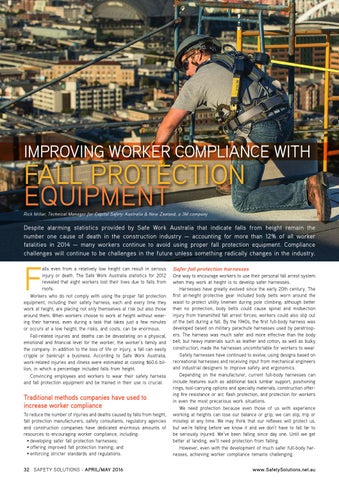IMPROVING WORKER COMPLIANCE WITH
FALL PROTECTION EQUIPMENT Rick Millar, Technical Manager for Capital Safety Australia & New Zealand, a 3M company
Despite alarming statistics provided by Safe Work Australia that indicate falls from height remain the number one cause of death in the construction industry — accounting for more than 12% of all worker fatalities in 2014 — many workers continue to avoid using proper fall protection equipment. Compliance challenges will continue to be challenges in the future unless something radically changes in the industry.
F
alls even from a relatively low height can result in serious injury or death. The Safe Work Australia statistics for 2012 revealed that eight workers lost their lives due to falls from roofs.
Workers who do not comply with using the proper fall protection equipment, including their safety harness, each and every time they work at height, are placing not only themselves at risk but also those around them. When workers choose to work at height without wearing their harness, even during a task that takes just a few minutes or occurs at a low height, the risks, and costs, can be enormous. Fall-related injuries and deaths can be devastating on a physical, emotional and financial level for the worker, the worker’s family and the company. In addition to the loss of life or injury, a fall can easily cripple or bankrupt a business. According to Safe Work Australia, work-related injuries and illness were estimated at costing $60.6 billion, in which a percentage included falls from height. Convincing employees and workers to wear their safety harness and fall protection equipment and be trained in their use is crucial.
Traditional methods companies have used to increase worker compliance To reduce the number of injuries and deaths caused by falls from height, fall protection manufacturers, safety consultants, regulatory agencies and construction companies have dedicated enormous amounts of resources to encouraging worker compliance, including: • developing safer fall protection harnesses; • offering improved fall protection training; and • enforcing stricter standards and regulations.
32 SAFETY SOLUTIONS - APRIL/MAY 2016
Safer fall protection harnesses One way to encourage workers to use their personal fall arrest system when they work at height is to develop safer harnesses. Harnesses have greatly evolved since the early 20th century. The first at-height protective gear included body belts worn around the waist to protect utility linemen during pole climbing; although better than no protection, body belts could cause spinal and midsection injury from transmitted fall arrest forces; workers could also slip out of the belt during a fall. By the 1940s, the first full-body harness was developed based on military parachute harnesses used by paratroopers. The harness was much safer and more effective than the body belt, but heavy materials such as leather and cotton, as well as bulky construction, made the harnesses uncomfortable for workers to wear. Safety harnesses have continued to evolve, using designs based on recreational harnesses and receiving input from mechanical engineers and industrial designers to improve safety and ergonomics. Depending on the manufacturer, current full-body harnesses can include features such as additional back lumbar support, positioning rings, tool-carrying options and specialty materials, construction offering fire resistance or arc flash protection, and protection for workers in even the most precarious work situations. We need protection because even those of us with experience working at heights can lose our balance or grip; we can slip, trip or misstep at any time. We may think that our reflexes will protect us, but we’re falling before we know it and we don’t have to fall far to be seriously injured. We’ve been falling since day one. Until we get better at landing, we’ll need protection from falling. However, even with the development of much safer full-body harnesses, achieving worker compliance remains challenging.
www.SafetySolutions.net.au
